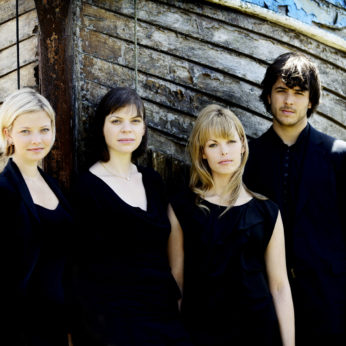Composer: Joseph Haydn (b. 1732 - d. 1809)
Performance date: 05/07/2016
Venue: St. Brendan’s Church
Composition Year: 1772
Duration: 00:20:00
Recording Engineer: Richard McCullough, RTÉ lyric fm
Instrumentation: 2vn, va, vc
Instrumentation Category:String Quartet
Artists:
Chiaroscuro Quartet (Alina Ibragimova, Pablo Hernán Benedí [violins], Emilie Hörnlund [viola], Claire Thirion [cello]) -
[quartet]

Composers are perhaps not quite as unworldly as we
like to think they are. In order to make as much money as possible from the
sale of each new set of six quartets, Haydn used to send them to several
different publishers, but in a different order each time so they would not be
immediately identifiable from catalogue listings. In the case of Op.20 there
are no less than four different orders with the C major appearing twice as No.3
and once each as Nos.5 and 2, providing material for much scholarly research.
Opus 20 is generally considered a critical point in
Haydn’s development of the string quartet. The great music scholar, Donald Tovey,
went so far as to state: With Op.20 the
historical development of Haydn’s quartets reaches its goal; and further
progress is not progress in any historical sense but simply the difference
between one masterpiece and the next. This set was composed shortly after
the two sets of Op.9 and Op.17 and when he came to his third set in four years
he had a particular problem to solve, namely the need to increase the weight of
the finale to offset the earlier dominance of the first movement. He tackled
this head-on by including three fugal finales so that their complexity of
thought immediately altered the internal balance of the quartet.
The other most noticeable change in these quartets is
that the monarch has been deposed and democracy installed in a bloodless
revolution. Whereas the first violin had ruled almost unopposed over long
stretches of the earlier quartets, Haydn now cultivates the spirit of give and
take that lies at the heart of the classical string quartet, each player
receiving a distinct identity. The C major Quartet underlines this new
democracy by opening with a string trio led by the second violin, followed by a
thoroughly unconventional trio with the two violins and the viola as bass. This
is a glorious movement where the four voices revel in this new-found equality.
The Capriccio is
neither more nor less than an operatic scena, beginning with a recitative where
cello and first violin in turn plead with an implacable orchestra, so vivid is
the impersonation you can almost hear the singers. The tension is eased
somewhat when the first violin takes off in a heart-easing cantabile aria, but the mood remains unsettled until the ethereal
minuet provides resolution. The finale is a riot, the four subject fugue wears
its learning lightly, exploiting the opportunity for witty banter. After
several pages of this light-hearted, softly spoken conversation the music
erupts into an assertive forte that
brings the movement to a fine conclusion.
Copyright © 2025 West Cork Music. All rights reserved.
Designed and developed by Matrix Internet